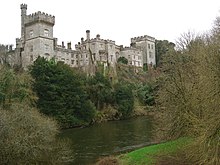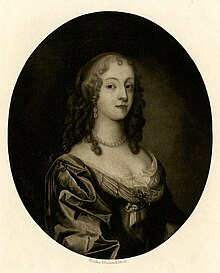Roger Boyle, 1st Earl of Orrery
Protectorate Parliament for County Cork | |
|---|---|
| In office 1654 – 10 December 1657 | |
| Personal details | |
| Born | 25 April 1621 Trinity College, Dublin |
| Military service | |
| Years of service | 1641 to 1651 |
| Battles/wars |
|
Roger Boyle, 1st Earl of Orrery,
Boyle was noted for his anti-
A noted writer on 17th-century warfare, Boyle helped design Charles Fort outside Kinsale. He also produced a number of plays and poems, which were well regarded by contemporaries but have since faded into obscurity.
Personal details


Roger Boyle was born 25 April 1625, twelfth born and third surviving son of Richard Boyle, 1st Earl of Cork (1566–1643), and his second wife, Catherine Fenton Boyle (1588–1630). A few months before his 7th birthday, his father granted him the Broghill estate in County Cork, and he was created Baron of Broghill in the Peerage of Ireland.[1]
His parents had a total of fifteen children, ten of whom survived into adulthood. The most notable included his eldest brother Richard (1612–1698), Katherine (1615–1691), a member of the Hartlib Circle, Mary Rich, Countess of Warwick (1624–1678), and the chemist Robert Boyle (1627–1691).[2]
In January 1641, he married Lady Margaret Howard (1623–1689), a daughter of the Earl of Suffolk. Their joyful wedding was immortalised in verse by Sir John Suckling as A Ballad upon a Wedding.[3] The couple had five daughters and two sons, his heir Roger (1646–1682), and Henry (1648–1693), father of the Earl of Shannon. His eldest daughter, Margaret (1644–1683), married Folliott Wingfield, 1st Viscount Powerscourt.
Career
Boyle entered
Rebellion and civil war
Boyle returned to Ireland on the outbreak of the
Subsequently, he originated a scheme to bring about the Restoration. On his way abroad to consult with King Charles II, he was unexpectedly visited by Oliver Cromwell in London. Cromwell informed him that his plans were well known to the council and warned against persisting in them. Cromwell offered him a command in Ireland against the rebels that entailed no obligation except faithful service. It was accepted.
Boyle's assistance in Ireland proved invaluable during the
By this time Broghill had become a fast friend and follower of Cromwell, whose stern measures in Ireland and support of the English and
Restoration
On Oliver Cromwell's death, Boyle gave his support to
He continued to exercise his office as
Boyle's writings
In addition to Lord Orrery's achievements as a statesman and administrator, he gained some reputation as a writer and a dramatist. He was the author of:
- An Answer to a Scandalous Letter ... A Full Discovery of the Treachery of the Irish Rebels (1662), printed with the letter itself in his State Letters (1742)
- Another answer to the same letter entitled Irish Colors Displayed ... also ascribed to him
- Parthenissa, a novel (1651, 1654–56, 1669)
- English-Adventures by a Person of Honor (1676), from which Otway drew his tragedy of the Orphan
- A Treatise of the Art of War (1677), a work of considerable historical value
There are some poems, of little interest, including verses:
- On His Majesty's Happy Restoration (unprinted)
- On the Death of Abraham Cowley (1677)
- The Dream (unprinted)
- Poems on most of the Festivals of the Church (1681)
Plays in verse, of some literary but less dramatic merit:
- Henry V (1664), heroic drama
- The Generall (1664), a tragi-comedy.[1] Samuel Pepys, 4 October 1664, called it "so dull and so ill-acted, that I think it is the worst I ever saw or heard in all my days."
- Mustapha (1665), tragedy
- Tryphon : a tragedy (acted 1668, Printed for H. Herringman, 1669)
- The Black Prince (acted 1667; printed 1669), heroic drama
- Herod the Great (published 1694 but unacted), tragedy
- Altemira (1702), tragedy
- Guzman (1669), comedy
- Mr. Anthony (1690), comedy
A collected edition was published in 1737, to which was added the fourth earl's comedy As you find it. The General is also attributed to him.
Footnotes
References
- ^ Wilson 1808, p. 149.
- ^ Barnard 2008.
- ^ Endicott, N. J. "A Ballad Upon A Wedding". Representative Poetry Online. University of Toronto.
- ^ Barnard 2004.
- ^ Manning 2003, p. 112.
- ^ a b c d History of Parliament Online – Boyle, Roger, 1st Baron Broghill.
- ^ John Gough Nichols, Autobiography of the Lady Halkett (London, 1875), pp. 105-7.
- ^ Oxford Dictionary of National Biography volume 7 (2002) p 110-111
- ^ T. W. Moody, F. X. Martin, F. J. Byrne A New History of Ireland, Volume III: Early Modern Ireland 1534–1691 Oxford University Press (1976) p. 420.
- ^ Fitgerald, Patrick. The history, topography and antiquities of the county and city of Limerick. p. 306.
- This article incorporates text from a publication now in the public domain: Chisholm, Hugh, ed. (1911). "Orrery, Roger Boyle, 1st Earl of". Encyclopædia Britannica. Vol. 20 (11th ed.). Cambridge University Press. p. 329–330.
Sources
- Barnard, Toby (2004). "Boyle, Roger (1621-1679)". doi:10.1093/ref:odnb/3138. (Subscription or UK public library membershiprequired.)
- Barnard, Toby (2008). "Boyle, Richard, first earl of Cork (1566-1643)". doi:10.1093/ref:odnb/3133. (Subscription or UK public library membershiprequired.)
- Manning, Roger (2003). Swordsmen: The Martial Ethos in the Three Kingdoms. OUP. ISBN 978-0199261215.
- Morrice, Thomas (1742). State Letters of Roger Boyle, 1st Earl of Orrery, edited with his life.
- Additional manuscripts (Brit. Mus.) 25,287 (letter-book when governor of Munster), and 32,095 sqq. 109–188 (letters);
- Article in the Oxford Dictionary of National Biography(2002)
- Athenae Oxonienses. Vol. iii. p. 1200.
- Biographia.
- "Preface". Orrery Papers. 1893.
- "Life of Roger Boyle". Contemporary History of Affairs in Ireland. 1879–1880.
- "Calendar of State Papers, Irish and Domestic".
{{cite journal}}: Cite journal requires|journal=(help) - Wilson, Joshua (1808). A Biographical Index to the Present House of Lords. T. Goddard, G. Richards and Cradock and Joy.
